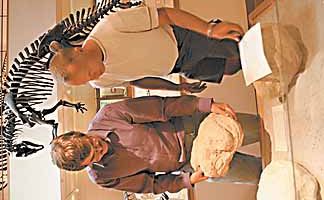| Reece Barrick shows one of the many dinosaur tracks that the CEU Prehistoric Museum has collected to Gerard Gierlinski, a Polish researcher. Gierlinski said that track fossils have not been as well recorded as bone fossils and are a kind of forgotten remnant of prehistoric life. |
Gerard Gierlinski thinks the College of Eastern Utah Prehistoric Museum is a great place to study dinosaur tracks.
“People find the bones in the field and that is what they concentrate on,” he said Thursday evening. “They fail to look around and see other things, like the tracks in the stone next to the fossils.”
Gierlinski is a fellow with the Polish Geological Institute in Warsaw, Poland. A very long way from home, he was obviously comfortable in the museum with the fossils and the tracks he loves so much.
“I like Utah,” he commented in his thick accent. “This is a beautiful place.”
Gierlinski said that few papers have been published on dinosaur tracks and that he is working to see and photograph as many as he can and he plans to publish on the subject.
“This museum has one of the best collection of tracks I have ever seen,” he stated. “This is a great museum for such a small town.”
Reece Barrick, paleontologist and the director of the museum, said the facility is always excited to have researchers visit, but when someone of Gierlinski’s caliber comes along he is especially impressed.
“Look how far he came to be here,” said Barrick as he watched Gierlinski work. “It’s truly wonderful to have international researchers want to come and look at what we have.”
Visitation by professionals and by lay people is largely what a museum is all about and with the beginning of tourist season Barrick and co-director Pam Miller announced some changes at the museum that will affect everyone who comes to see the exhibits.
Beginning today, June 1st the museum will institute an admission fee. Historically the CEU Prehistoric Museum has had free admission. But like many museums across the country, the CEU Prehistoric Museum is facing the challenge of increasing expenses without matching increases in revenue.
According to a musuem media advisory, the “funding comes from a variety of sources: foundations, corporations, endowments, individual donations, gift shop sales, Price city and the College of Eastern Utah. While the money we receive from these sources generally remains stable, the services we offer or are expected to offer and the staff required to support those services has continued to grow.”
According to Barrick and Miller the idea for charging an admission fee began in the winter of 2002. The museum received a grant from the Institution of Museum and Library Services to hire two consultants to evaluate the educational and public programs.
The consultants reported that the museums educational services to the public schools needed significant expansion and the attention of a full-time Curator of Education. They suggested that a means of funding growth in the educational programs would be the introduction of admission fees to the museum.
“The decision to begin charging a fee did not come easily,” the release stated. “In spring of 2003 the museum staff and advisory board members researched the issues faced by museums when they go from donations to required admission fees.”
It continued, “All positive and negative issues associated with admission fees were studied in detail, including the impact on our stakeholders, everyone from visitors to members to volunteers.”
Ultimately, the institution of an admission fee became absolutely necessary. The funds will be used to build public educational programs and continue the growth of the kindergarten through high school programming. The museum is accredited by the American Association of Museums.
“The expectations for maintaining accreditation are raised each year,” stated the release. “A full-time educator and funds for implementing new educational programs will go far in helping the museum maintain its accreditation status and increase the quality and variety of educational programs for children and our visitors in general.”
The museum is also a state and federal repository for arheological and paleontological collections. This means that dinosaur bones or ancient artifacts collected by the museum will remain here in Castle Country and eastern Utah for the benefit of residents and stakeholders.
“If we don’t maintain our accreditation our collections from public lands would go to other museums,” noted the release.
Presently, the museum’s annual donations average approximately $0.80/person while serving over 30,000-40,000 yearly.
“By keeping our required fees to what has been our requested donation, the museum will remain one of the most economical educational and recreational experiences in the state,” it was noted in the release.
Barrick and Miller said in order to reduce the impact of admission fees on regular and local visitors, the museum has revised its associate membership program and will provide member families with an annual pass to the museum for the a minimal cost of $30. Benefits of membership will include a quarterly newsletter and a 10 percent discount on all items in the museum gift shop. The Museum will also be including one free museum pass to Price City residents in their June utility bills.
School groups will continue to enjoy free admission if their tours are scheduled two weeks in advance.
For all other visitors the fees will be: two years and under, free; 12 years and under, $1; 13 years and over, $3. A family admission will also be available; two adults and their children living in one house will cost $7.
“We hope that people will understand why we have to do this,” said Miller. “It’s just a matter of offering programs and economics.”

